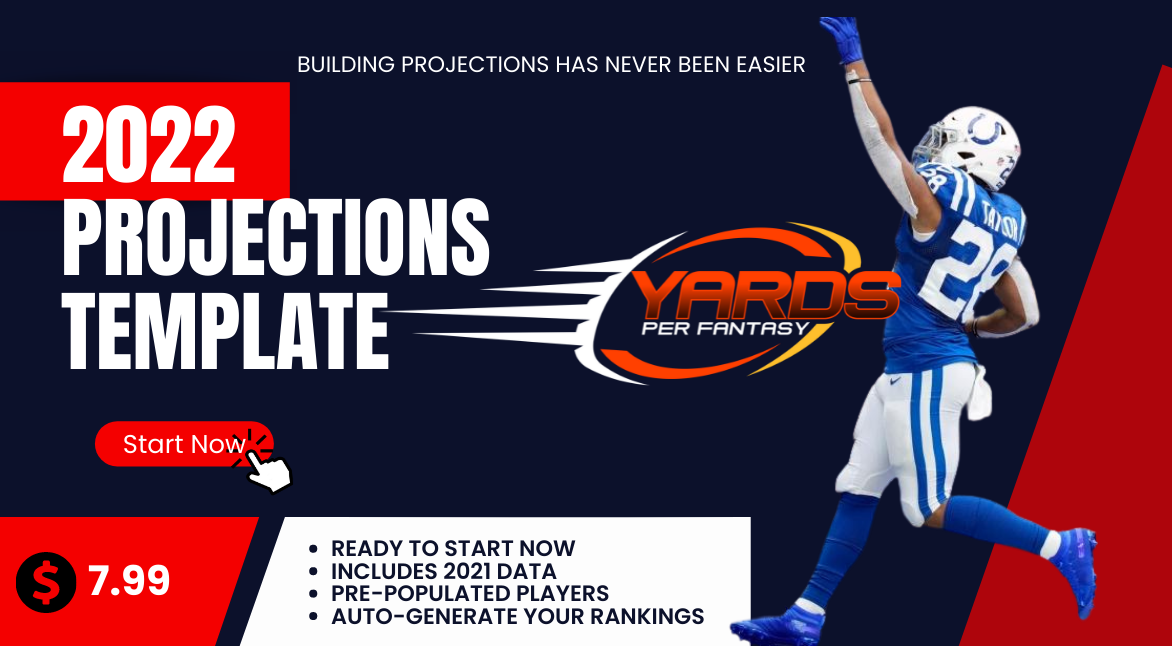 Draft With Us On Underdog! Use Promo-Code: YARDSPER for a 100% deposit match up to $100!
Draft With Us On Underdog! Use Promo-Code: YARDSPER for a 100% deposit match up to $100!
Fantasy Football Auction Draft Basics
Ever been interested in trying an auction draft but don’t know where to start to begin to prepare? Or have you been doing auction drafts for a few years, but want to take your preparation to the next level with a more principled, methodical approach? Whether you’re an experienced auction player or new to the format, I’m here to help you improve your preparation for auction/salary cap drafts!
The Fantasy Football Auction Roadmap will soon be releasing for purchase on Yards Per Fantasy. The Roadmap will provide readers with an in-depth look at the best ways to prepare yourself for an auction draft to optimize performance around the factors you can control. Included in the Fantasy Football Auction Roadmap:
- Auction draft basics
- A description of psychological and behavioral-economic factors at play in an auction and how you can avoid their pitfalls/use them to your advantage
- Factors to consider when determining player values
- How to conceptually think about player values, and adjust those values based on the actual results of the auction
- Player nomination strategies both early and late in the auction, and my favorite players to nominate for different reasons
- Various budgeting and roster construction strategies you can use, and how to execute those strategies
- Other personal favorite philosophies and strategies of mine
- How auction draft concepts can help you in snake drafts, and a consideration of how common snake draft strategies may or may not apply to auction drafts
- Draft day excel document to track player values (for both superflex and non-superflex leagues) and adjust those values for “live prices” based on actual results of the auction as it progresses. The draft day document will also include example budgets and potential player nominations.
This article is part of a series of articles that will provide a sneak peak at some of the types of concepts you can expect to learn about in the Roadmap. In this article, we’re starting at the beginning with some of the basics of auction drafts. What is the basic format of an auction draft and how is it different from a snake draft?
Overview
In an auction draft, each manager receives the same starting budget. In most auction drafts, the starting budget is $200, although this can vary based on league settings. Managers take turns nominating players for auction one-by-one, and all managers bid on the nominated player. League members may bid up to whatever amount they feel a particular player is worth (within the confines of their remaining budget), and ultimately the manager with the highest final bid ‘wins’ the auctioned-off player. Managers continue to nominate players for auction until every team’s roster is filled.
Nomination Process
With respect to the nomination process, league members take turns nominating players. Setting the nomination order is generally irrelevant and is typically randomized. Once everyone has had a chance to nominate a player, it returns back to the first team to nominate again. That is, nominations do not typically go in a ‘snake’ order like traditional fantasy leagues or best ball leagues (though, if your league prefers, I suppose there’s nothing that would stop you from doing it).

When nominating a player, a manager must provide an opening bid on that player. This opening bid must be at least $1, meaning if a player is nominated and no other managers bid on that player, the manager who nominated that player wins the auction and gets that player on their team for the amount of their opening bid. The opening bid need not be $1; the nominating manager may place as high an opening bid as they would like within their remaining budget constraints.
A manager may nominate any player they would like when it is their turn to nominate. That is, there is no pre-determined order in which the pool of players must be put up to auction. As an example, if I am making the first nomination in the draft, there is no requirement that I nominate Jonathan Taylor, Christian McCaffrey, Cooper Kupp, or any other star player. I could put any player I would like up for auction, including a player that is traditionally going in the later rounds of snake drafts like Allen Lazard. This is a key aspect of an auction draft because the point in the draft at which a player is nominated can heavily influence the ultimate price paid for the player. Typically (though not always), the earlier a player is nominated, the more money will be spent on that player, as there is more money available to be spent across the league early in the draft.
Budget and Maximum Bids
As noted above, every league member starts with a pre-set budget, which most commonly is $200. The manager may use this ‘money’ to bid on players however he or she sees fit. However, his or her roster must be completely filled (i.e., if a roster in the league has 16 players, the manager must leave the draft with 16 players), and every player must have at least $1 spent on them (i.e., the manager cannot win a player for $0). Bids may only be made in increments of $1 (i.e., no bids of certain amounts of cents).
Based on the above guidelines, the ‘maximum bid’ a manager can make on a player at a given time is an amount that still leaves the manager with $1 for any remaining roster slots. For example, in a league in which each team has 16 roster spots and the beginning budget is $200, when the draft first begins, each manager’s maximum bid is $185 ($200 minus $15 for the remaining roster spots).
PROJECTIONS TEMPLATE – GET NOW!
Benefits of Auction Drafts over Snake Drafts
Given most fantasy football players are accustomed to the snake draft format, it is worth considering some of the key differences between an auction draft and a snake draft, and how you might be able to persuade you league mates (or yourself) to make the switch over to an auction draft.
- Every Player is Available to Everyone: The most important difference from a snake draft is that, in an auction, every manager has a chance to get any player they would like on their team (cue Bob Barker) IF the price is right. In contrast, in a snake draft, there are certain players that, by nature of my draft position, I simply will not have a chance (or it will not make sense) to get on my team. If I’m drafting at the back of the first round, I’m not going to be able to get Jonathan Taylor on my team, no matter how much I might value his services. In contrast, in an auction draft, instead of the owner of Jonathan Taylor being determined by a draft order randomizer, any league member can get him on their team, but they need to value his services more than every other manager.
- Flexibility in Roster Construction: Because every player is available to every manager, this also affords every manager much more flexibility in how a roster is constructed. Because you pick at certain increments in a snake draft, you will inevitably be left with a gradually declining quality of player (at least by market value). This is because I’m being told when to pick a player in a snake draft. In an auction draft, a manager is free to construct his/her roster as he/she sees fit. For example, one manager might pay up for three first-round talents, and fill the rest of his roster with sixth round or later players, while another manager might not win any first round ADP players and instead go after five players in the second or third round to set the foundation of his team. Both strategies are viable, and both are possible in an auction draft; but a snake draft does not afford you that flexibility.
- Market Prices Reflect Tier Breaks: In an auction draft, the price of each individual player, or a tier of players of similar value, is more reflective of their actual price/value than the spot they may be drafted at in for a snake draft. To illustrate this point, consider in a snake draft those moments when you are 2 picks away from your next selection. How often have you said to yourself, “I just hope either Player X or Player Y gets to me.” You think they both are similar quality, but if both players are gone, you’ll be forced to draft a much worse player. Lo and behold, both of those players go off the board in the two picks before you, and now you are forced to take a player of a significantly worse caliber. The difference in value of the pick of the person one pick ahead of you compared to yours is much greater than simply one draft spot, since the manager ahead of you got a significantly better player. However, a snake draft does not account for potential tier breaks in dolling out value to drafters. In contrast, in an auction draft, the value of these sorts of tier breaks is better accounted for. Even if I were to miss out on both Player X and Player Y in the above example, I at least would take solace in knowing that the next player I would be forced to draft would not cost essentially the same price. I might even be able to get two lower quality players instead, so it is a more fair trade-off.
- Influence Over the Price Paid for Players: The nature of an auction allows you to influence the price that others will pay for the players that they draft. This is due to the nomination system and having freedom to nominate whoever you would like when it is your turn, as well as the ability to participate in the bidding process. The amount of influence over prices paid will vary from auction to auction based on the tendencies of other league members and the timing of player nominations.
The chance to have any player on your roster and flexibility to construct your roster how you want, combined with a more fair way to price the value of these players and a bit of chance/chaos sprinkled in make for an all-around more fun draft experience. Still, one of the big deterrents I hear from people as to why they don’t want to switch from snake to auction drafts is that they are afraid they won’t know what they’re doing, overpay for a player or two, and their season will be sunk before it even begins.
To that, I would say it is difficult to butcher an auction draft so badly that your team can’t compete week one. That’s because people generally will only bid up until they believe the player is at a fair price. In other words, for you to totally blow your budget and overspend so badly on a player, it would take another manager to tango with you. You can’t drive the price up too high yourself without somebody else bidding against you. Have I seen it happen? Sure. But it is rare, and if you have any sort of price sheet or average auction value to work off of, you should be able to contain yourself to a reasonable price and stay away from cavalier spending.
So with that in mind and the basics under your belt, don’t be scared – stay tuned for more auction articles focused on tips and tricks to prepare, dive into an auction draft, and buckle up for the most fun fantasy draft experience you’ve ever had!






